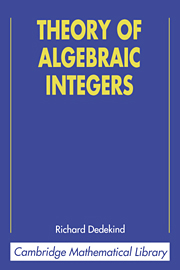4 - Elements of the theory of ideals
Published online by Cambridge University Press: 06 January 2010
Summary
In this chapter we shall develop the theory of ideals to the point indicated in the Introduction, that is, we shall prove the fundamental laws which apply to all fields of finite degree, and which regulate and explain the phenomena of divisibility in the domain o of all integers in such a field Ω. The latter are what we refer to when we speak of “numbers” in what follows, unless the contrary is expressly indicated. The theory is founded on the notion of ideal, whose origin has been mentioned in the Introduction, and whose importance has been sufficiently illuminated by the example in Chapter 2 (11 and 12). The exposition of the theory that follows coincides with the one I have given in the second edition of Dirichlet's Vorlesungen über Zahlentheorie (163). It differs mainly in external form; however, if the theory has not been shortened it has at least been simplified a little. In particular, the principal difficulty to be surmounted is now thrown more clearly into relief.
Ideals and their divisibility
As in the previous chapter, let Ω be a field of finite degree n, and let o be the domain of integers ω in Ω. An ideal of this domain o is a system a of numbers α in o with the following two properties:
I. The sum and difference of any two numbers in a also belong to a, that is, a is a module.
II. The product αω of any number α in a with a number ω in o is a number in a.
- Type
- Chapter
- Information
- Theory of Algebraic Integers , pp. 119 - 152Publisher: Cambridge University PressPrint publication year: 1996



